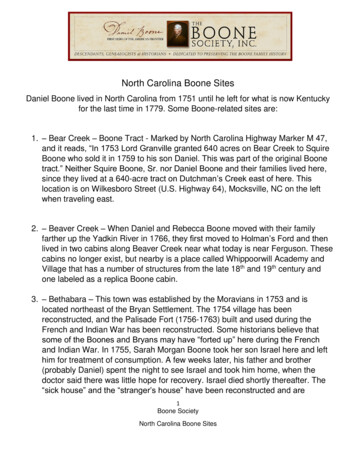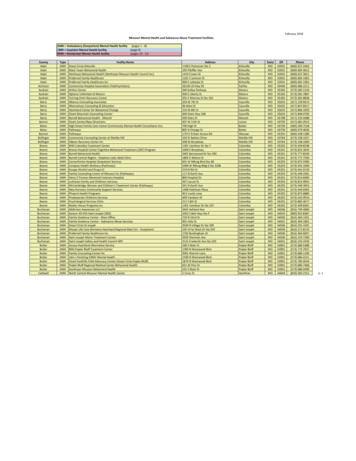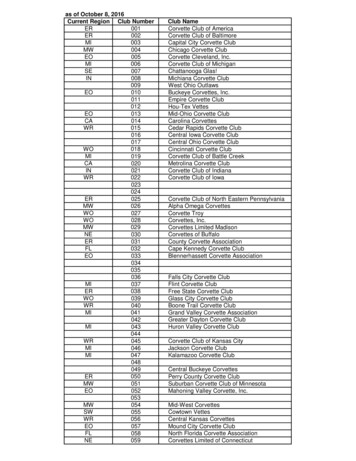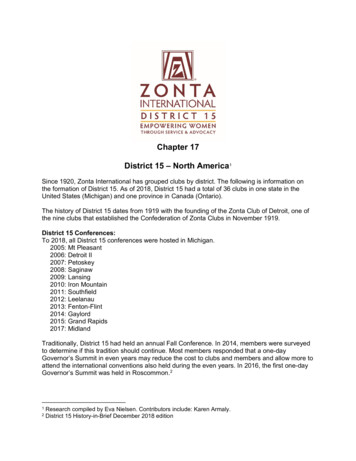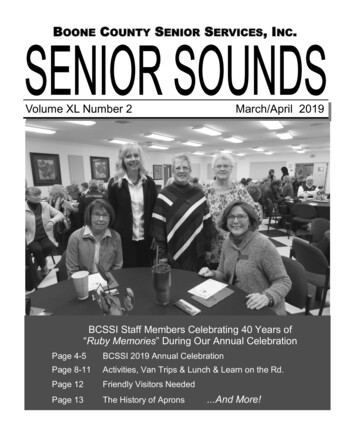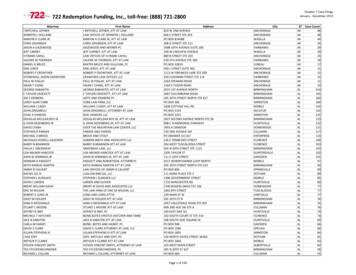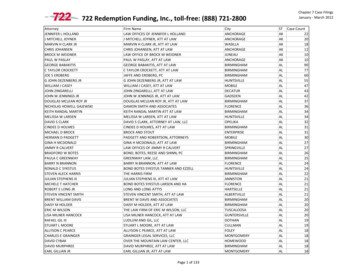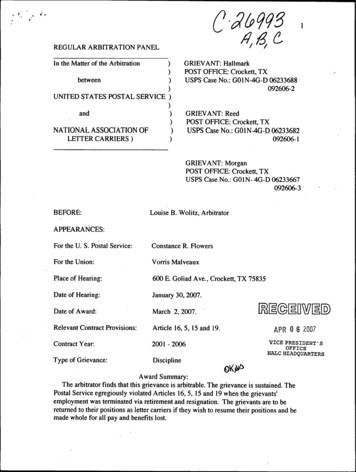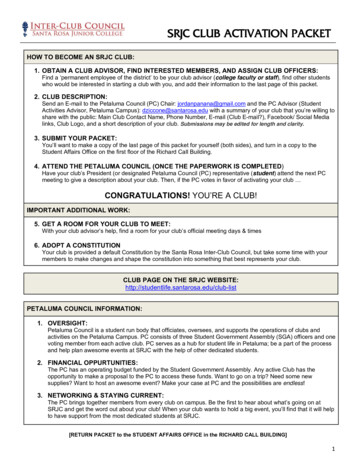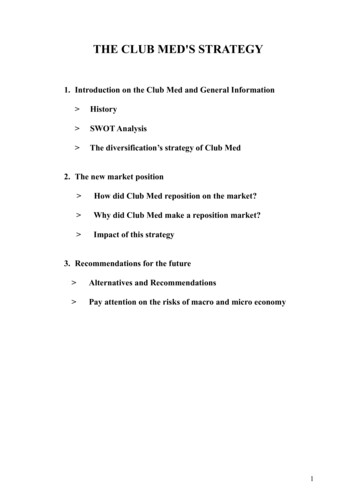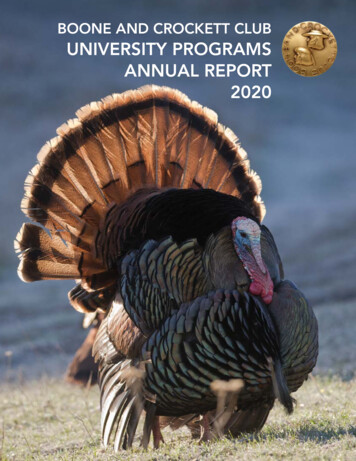
Transcription
BOONE AND CROCKETT CLUBUNIVERSITY PROGRAMSANNUAL REPORT2020
2020 AT A GLANCE 5,500,000 TOTAL EXTERNAL GRANT FUNDINGFOR RESEARCH ORALBOONE AND CROCKETTUNIVERSITY PROGRAMSSPONSORED BY2Cover photo by Donald M. Jones9 GRADUATESFROM BOONE AND CROCKETTUNIVERSITY PROGRAMS3 ENDOWED PROFESSORS20AWARDS FOREXCELLENCE38 5SCHOLARLYPUBLICATIONSPOPULARARTICLES14 45INVITEDTALKSClemson University (in development)Michigan State UniversityMississippi State University (inactive)Oregon State University (inactive)RESEARCHPRESENTATIONS5COURSESTAUGHTTexas A&M UniversityTexas A&M University-KingsvilleUniversity of MontanaUniversity of Wisconsin-Stevens Point
WELCOMEWe are pleased to share the accomplishments of the Boone and Crockett Club’s University Programs for 2020.As with every aspect of our lives this year, University Programs experienced challenges and changes. The biggestchange was the loss of Dr. Bill Porter, the longest-serving of the three B&C Professors and the leader who helpedUniversity Programs harness science and education in support of the Club’s mission. We are honored to pick up the reins as deputy chairsand continue to facilitate University Programs’ work in the service of wildlife conservation, education, and policy. We thank Bill Demmer,Rose Stewart, and Karlie Slayer for their continued and capable support and guidance during the transition.While we are excited to report our activities of the past year, University Programs, by its nature, is a forward-looking effort. Its mission isto invest in the future by training the best and brightest students, then placing them in jobs where they can make a difference. There areimmediate payoffs because Fellows’ research informs policy decisions in real time. However, the big payoffs come years, sometimes decades,later as B&C Fellows work their way into positions of influence. They bring their conservation values to these positions, fulfilling theClub’s legacy. In turn, B&C Fellows know that the Club is there to support them and to make conservation happen.Dave Hewitt and Josh MillspaughUniversity Programs,Deputy Co-ChairpersonsPHOTO BY JONATHAN TRUDEAUMichigan State PhD student JonathanTrudeau captured this image of midMichigan’s winter landscape whilehauling gear to a trapping site for hiswhite-tailed deer movement study.THE BOONE AND CROCKETT CLUBIt is the mission of the Boone and Crockett Club to promote the conservation andmanagement of wildlife, especially big game and its habitat, to preserve and encouragehunting, and to maintain the highest ethical standards of fair chase and sportsmanshipin North America.The Boone and Crockett Club’s University Programs help serve this mission byattracting the brightest students to the strongest universities to work with theforemost wildlife faculty.Our Boone and Crockett Fellows are engaged in more than 20 research projectsfocused specifically on big game species, and an equal number of studiesdesigned to improve habitat management. We offer them opportunities to seethe value of hunting both in the classroom and afield. They leave the programwith a deep understanding of the Club’s legacy and its values, ready to tacklethe big issues facing wildlife conservation today.STAY UP TO DATE WITHUNIVERSITY PROGRAMS INFAIR CHASE MAGAZINEEach issue of Fair Chasemagazine includes an updatefrom our University Programs.Individual schools, projects, andstudents are profiled as a way toinform our readership on currentUniversity Program happenings.Learn more atwww.Boone-Crockett.org3
2020 UNIVERSITY PROGRAMS EVENTSWILDLIFE MANAGEMENT INSTITUTE’S 85TH NORTH AMERICANWILDLIFE AND NATURAL RESOURCES CONFERENCEAt the Boone and Crockett Club 2020 Spring meeting, held in conjunction with the WildlifeManagement Institute’s 85th North American Wildlife and Natural Resources Conferenceon March 8-13, 2020 in Omaha, Nebraska, two B&C Fellows presented at the luncheon onThursday, March 12.B&C FELLOW PRESENTATIONS AT THE B&C SPRING MEETING:Vaughan Branch: M.S. student - U of MontanaCrisis Drives Innovation in Wildlife Funding ParadigmAshley Huinker: M.S. student - Michigan StateUnderstanding Woodcock Breeding Habitat in Michigan’s Lower PeninsulaTHE WILDLIFE SOCIETY CONFERENCEThis year’s Wildlife Society Conference was held virtually September 28 - October 2, 2020. Thisconference is the largest gathering of wildlife professionals and students in the U.S. and the Booneand Crockett Club was an event sponsor this year. Once again the Club was well-represented byour graduate fellows who presented posters and talks in various symposia.More than 2,500 participants—a record number—took part in a week of informative symposiaand talks, thought-provoking panels, and chances to connect with fellow wildlifers from afar.B&C FELLOW PRESENTATIONS AT THE TWS VIRTUAL CONFERENCE:Levi Heffelfinger: Ph.D. student - TAMU-KingsvilleModeling Spatial Mate Search Strategies and Interactive Networks DuringMule Deer ReproductionChris Hoving: Ph.D. student - Michigan StateManagers as Part of the System: Fire and Climate Adaptation in the AnthropoceneNick Jaffe: Ph.D. student - Michigan StateAdapting Habitat Suitability in a Dynamic Seasonal EnvironmentEllen Pero: Ph.D. student - U of MontanaOne Size Does Not Fit All in Population Restoration: Genetic Considerationsfrom the Missouri Elk RestorationNoelle Thompson: Ph.D. student - Michigan StateEvaluating the Complexity and Uncertainty Associated with Managementof Chronic Wasting DiseaseJonathan Trudeau: Ph.D. student - Michigan StateConvenience or Selection? A Look at the Resource Selection of Michigan White-tailed DeerUNIVERSITY PROGRAMS WEBINARSIn 2017, University Programs began a series of webinars for B&C fellows that are hosted byregular and professional member of the Club. The goal of these webinars is to link Boone andCrockett fellows closer to the Club by promoting 1) interaction with regular and professionalmembers, 2) a common set of experiences, and 3) the fellows’ professional development. Inpast years, the webinar series has hosted members including Wini Kessler, Jim Heffelfinger, andJames Cummins. Early in 2020, Ben Wallace hosted a webinar that focused on the structureand history of the Club. Later in the year, Lowell Baier led a webinar about the importance ofwildlife conservation on private lands. As part of the latter, B&C Fellows read the Introductionand Chapter 1 of Lowell’s new book Saving Species on Private Lands to provide background forthe Noelle Thompson, PhD CandidateDr. Sonja ChristensenDr. David WilliamsDr. William PorterBoone and Crockett Quantitative Wildlife CenterDepartment of Fisheries and WildlifeMichigan State UniversityPhoto credit: J. Trudeau
IN MEMORIAMThe Boone and Crockett Club’s UniversityPrograms Committee mourns the loss of Dr.William “Bill” Porter, who passed away fromcancer on October 23, 2020 at the age of 69.After a distinguished 30-year career atSUNY College of Environmental Scienceand Forestry, Bill came to Michigan StateUniversity in 2010 to become its firstBoone and Crockett Professor of WildlifeConservation. During his time at MSU,he founded the Boone and CrockettQuantitative Wildlife Center, developedand taught courses focused on wildlife policyand leadership in natural resources, andmentored 6 post-doctoral scholars, 13 Ph.D.students, 4 M.S. students, and numerousundergraduate students.Bill’s work at Michigan State focusedon applied science aimed directly at wildlifeconservation. He was dedicated to making adifference in four key areas: land-use change,emerging wildlife diseases, shifting weatherpatterns, and sustainable management ofwildlife. His research spanned many speciesof interest to the wildlife community,including deer, wolves, bears, woodcock,songbirds, and his first ecological love: thewild turkey. This year’s cover of the Booneand Crockett University Programs AnnualReport is a tribute to Bill and his favoritegame species.Bill was equally devoted to producingthe next generation of wildlife conservationleaders. He fostered creative problemsolving in his students and emphasizedtraining in collaborative leadership andeffective communication skills. When hewas not teaching or meeting with studentsand collaborators, Bill was sharing his vastknowledge of wildlife conservation bypublishing more than 150 journal articlesand book chapters on topics ranging from thehistory of the land conservation movementto white-tailed deer movement behavior.Early in his tenure at Michigan State,Bill worked with the program’s foundingmembers to establish the MichiganBoone and Crockett Partners group, anengagement committee comprised ofregular and professional B&C members,Michigan Department of Natural Resourcesstaff, stakeholders, and MSU Collegeof Agriculture and Natural Resourcesleadership. The Partners group met at leasttwice a year to discuss program prioritiesand needs, and receive updates from B&CFellows about their work.Bill was not afraid to take on the“wicked problems” that threaten wildlifeconservation in the 21st century. Oneexample of this is chronic wasting disease.With the support of the Michigan Booneand Crockett Partners group, he secured 1.6 million in research funding andestablished a team of 3 PhD students and2 post-doctoral researchers to lead projectsaimed at finding CWD early and identifyingmanagement strategies that reduce diseasetransmission. This work is ongoing andearly results are already being used by statewildlife agencies in the Midwest to prioritizemanagement efforts and shape policy.One of Bill’s greatest professional joyswas his work with the Club’s UniversityPrograms Committee, where he servedas Deputy Chair from 2015 to 2020.During his time in this role, Bill helpedto orchestrate a strategic planning processaimed at constructing a practical visionfor University Programs that aligns withthe mission of the Club, and buildingnew relationships between members andfellows. His excitement for this initiativewas contagious, and he will always beremembered for his role in strengthening theUniversity Programs network.Bill was a champion for wildlifeconservation, a valued colleague, a talentedmentor, a loyal friend, and a dedicatedhusband, son, father, and grandfather. Heleaves a legacy that will shape wildlifemanagement and policy for years to come.It is not the critic who counts; not the man whopoints out how the strong man stumbles, orwhere the doer of deeds could have done thembetter. The credit belongs to the man who isactually in the arena, whose face is marred bydust and sweat and blood; who strives valiantly;who errs, who comes short again and again,because there is no effort without error andshortcoming; but who does actually strive todo the deeds; who knows great enthusiasms,the great devotions; who spends himself in aworthy cause; who at the best knows in the endthe triumph of high achievement, and who atthe worst, if he fails, at least fails while daringgreatly, so that his place shall never be withthose cold and timid souls who neither knowvictory nor defeat.- Theodore RooseveltWe will miss you in the arena, Bill.Univeristy Programs retreat atthe TRM Ranch, 2018.Photo by Bill Porter.5
2019 BOONE AND CROCKETT FELLOW OUTSTANDINGACHIEVEMENT AWARD IN GRADUATE RESEARCHAt the Annual Meeting last December DanielP. Thompson was announced as the first winnerof the Boone and Crockett Fellow OutstandingAchievement Award in Graduate Research. TheBoone and Crockett Club established this award toformally acknowledge the achievements of Booneand Crockett Fellows. The award highlights andstrengthens the connection between students andmembers of the Boone and Crockett Club.The Boone and Crockett Club’s UniversityPrograms offers educational and professionaldevelopment opportunities that prepare futurescientists, decision-makers, and leaders to address theenormous challenges facing wildlife conservation.The Club established the annual Boone andCrockett Fellow Outstanding Achievement Award torecognize a graduate student whose research advancesthe Club’s mission and informs natural resourcemanagement and policy decisions in North America.Awardees are selected on the basis of the relevanceand significance of their research, the quality of theirwork, and their commitment to leadership, effectivecommunication, and outreach.During the award presentation, Boone andCrockett Club President Timothy C. Brady said,“On behalf of the Boone and Crockett Club andits University Programs Committee, I'd like tocongratulate Daniel on being awarded the first Booneand Crockett Fellow Outstanding AchievementAward in Graduate Research. His work is anexcellent example of research that brings meaningand understanding to the Club's mission and strategicvision. His role with the Alaska Department ofFish and Game demonstrates his ability to lead inresearch that will make a difference to managementof landscapes for big game.”6LEFT TO RIGHT: Chad Bishop, B&C Professional Member and Director and AssociateProfessor of the Wildlife Biology Program at the University of Montana, Daniel P.Thompson, B&C Fellow, Perry S. Barboza, Boone and Crockett Chair in WildlifeConservation & Policy at Texas A&M University, Timothy C. Brady, B&C President.During a luncheon at the Annual Meeting, Chad Bishop provided background onthe award and Daniel, who was introduced by his mentor Perry Barboza, gave apresentation about his research to Club members.BOONE AND CROCKETT FELLOW - DANIEL P. THOMPSONPH.D. STUDENT - TEXAS A&M UNIVERSITYWILDLIFE BIOLOGIST, ALASKA DEPARTMENT OF FISH AND GAMEDissertation Title: Evaluating the physiological and behavioral responsesof moose (Alces alces) to fluctuating environmental temperaturesDan’s research evaluated how moose respond, both physiologically andbehaviorally, to daily and seasonal fluctuations in environmental temperatureon the Kenai Peninsula, Alaska. Using internal temperature sensors inmoose, he looked at daily and seasonal body temperatures to determinewhen they may become stressed from warm environmental temperatures.Using captive moose, he evaluated howindividual moose respond physiologicallyto warm environmental temperaturesusing techniques including heart ratebelts, salivary and fecal stress hormonelevels, and forward looking infraredthermal images. With wild moose, heevaluated behavioral responses to warmenvironmental temperatures using GPScollars to determine habitat selection andactivity. Understanding habitat selectionof moose for both thermoregulationand habitat quality will allow wildlifemanagers to identify areas that canprovide both thermal relief and adequateforage for moose during seasonally warmtemperatures when planning habitatimprovements for these populations.
WHERE ARE THEY NOW?Since 1992 more than 100 Boone andCrockett Fellows have completed coursesof study in wildlife conservation andrelated fields.Bryan StevensA Boone and Crockett Fellow is an undergraduate or graduate student, or postdoctoralassociate, who is supported by Boone and Crockett funding and/or advised by a Booneand Crockett Professor or Professional Member. In addition to displaying academicexcellence, Boone and Crockett Fellows are committed to scholarship that:nnPromotes effective conservation policy through dedication to research, education,outreach and service.Exhibits leadership in wildlife conservation.nHelps others understand the mission of the Boone and Crockett Club and theevolution of conservation in America.nRecognizes and appreciates the values of hunting and fishing and the principles offair chase.Dr. Bryan Stevens (Ph.D. 2016, Michigan State University) completed his doctoraldegree under the mentorship of Dr. Bill Porter, where he developed populationassessment and decision support tools to inform wild turkey harvest management inMichigan. While completing his doctoral degree, Bryan also worked directly withmanagement stakeholders and other scientists to evaluate turkey management optionsusing structured decision making. Following completion of his degree, Bryan and hiswife headed west to Idaho, where he was hired as a postdoctoral research associate withthe Idaho Cooperative Fish and Wildlife Research Unit and then promoted to ResearchScientist in 2018. His recent research has included modeling habitat for wetland birds,developing population assessment tools to inform management of white-tailed deerharvests, and modeling vital rates for greater sage-grouse. Bryan is currently based inMoscow, Idaho.Tessa HasbrouckTessa Hasbrouck (B.S. 2014, University of Wisconsin Stevens Point) completed herundergraduate fellowship at UWSP under the mentorship of Dr. Eric Anderson, whereshe studied bobcat home-range size and habitat characteristics in Wisconsin. Followingcompletion of her B.S. degree, Tessa’s interest in wildlife and big game research broughther home to Alaska, where she received a Master’s degree at the University of AlaskaFairbanks. Her M.S. research, which was funded by the National Science Foundation,focused on quantifying effects of environmental factors and hunter overlap on mooseharvest in Interior Alaska. This work uncovered complex interactions betweenweather and hunter harvest, and provides managers and hunters with information thatmay be used to refine regulations and inform hunt locations and strategies. Tessa washired as an Assistant Area Management Biologist in 2019 by the Alaska Departmentof Fish and Game, Division of Wildlife Conservation. She is currently based inKetchikan, Alaska.Dr. Mark Steinbach (Ph.D. 2004, University of Montana) completed his doctoralMark Steinbachdegree under the mentorship of Dr. Jack Ward Thomas, where he evaluated theconsequences of public land grazing permit buyout programs, permit reductions,and increased fees on land ownership and open space in Western states. A native ofTexas, he worked as a private lands wildlife biologist with Texas Parks and WildlifeDepartment upon completion of his degree. His graduate work in the policy arenaand working with landowners was the perfect steppingstone to his current workin the non-profit sector. Mark joined the staff of the Texas Land Conservancy,a statewide land trust, in 2007 and currently serves as Executive Director of theorganization. His work focuses on protection of Texas land from the negative effectsof land fragmentation by working with private landowners as well as state and federalagencies. Mark is currently based in Austin, Texas.7
MICHIGAN STATE UNIVERSITYMICHIGAN STATE UNIVERSITY BOONE AND CROCKETT PROGRAMWith roots in the northern hardwood forests, Great Lakes, and agricultural ecosystems of the upper Midwest,Dr. William PorterMichigan State University (MSU) is home to one of the premier fisheries and wildlife programs in the nation. TheBoone and Crockett Program at Michigan State University was established to educate bright individuals with a deeppassion for wildlife conservation. Central to the program is the Boone and Crockett Quantitative Wildlife Center(QWC), where research focuses on four game-changing issues: land-use change, shifting climate patterns, emerging wildlife diseases andsustainable management of wildlife. We encourage our Boone and Crockett Fellows in creative, innovative problem-solving and emphasizeeducational experiences that prepare them for a seat at the table where the big decisions about wildlife conservation are made.POLICY IMPACTJon Cook’s (PhD, 2020) research on identifying areas at high risk fornew CWD detection is being implemented into disease response plansin Michigan, Indiana, and Ohio. His novel application, which usesexpert knowledge to identify risk, has been well received by scientistsand managers in the Midwest Association of Fish and WildlifeAgencies (MAFWA). This approach equips state agencies withupdated strategic approaches to disease monitoring and positions themfor greater potential to find wildlife diseases early.BOONE AND CROCKETT FELLOWLESLIE SKORALeslie grew up in metro Detroit where she developed aninterest in the outdoors and horseback riding at a youngage. She received her bachelor’s degree in natural resourcesmanagement from Grand Valley State University. Herinterest in horses led her to Wyoming, where she worked asa pack mule guide on backcountry trips. Leslie was hired bythe National Park Service in 2013 to monitor brown bearabundance at Katmai National Park in Southwest Alaska,soon realizing that there was an opportunity to use complexecological modeling tools to better understand changes in thebear population over time. Now a wildlife biologist at Katmai,she is completing her M.S. work at MSU to answer thesequestions. Leslie plans to continue to work at the agencyupon completion of her degree, integrating the quantitativetools she has acquired to explore new research questions.FUNDING SOURCESn MichiganDepartment of Natural ResourcesHal and Jean Glassen Memorial Foundationn MSU College of Agriculture and Natural Resourcesn MSU Extensionn MSU AgBioResearchn MSU/Michigan DNR Joint Wildlife Disease Initiativen MSU Boone and Crockett Club endowmentn TheABOVE: Field Technician Steven Gurney placing a trail camera as part of a studylooking at impacts of harvest regulations on deer population characteristics inareas where CWD has been detected.8
UNIVERSITY OF MONTANAUNIVERSITY OF MONTANA BOONE AND CROCKETT PROGRAMLong known for its exceptional big game research, the University of Montana hosted the original Boone andDr. Joshua MillspaughCrockett Professor, beginning in 1987. The Boone and Crockett Program at Montana is focused primarily onthe integration of wildlife conservation and land management. Our program addresses society’s most significantwildlife and natural resource challenges through collaborative, relevant, and high-caliber research and teaching. The Program preparesfuture conservation leaders through science-based instruction that promotes wise stewardship, application of the best available science,and informed policy decisions. A key component of the research-teaching effort is centered on the Boone and Crockett Club’s TheodoreRoosevelt Memorial Ranch and the Elmer E. Rasmuson Wildlife Conservation Center near Dupuyer, Montana. The 6,000-acre workingcattle ranch and the Center are adjacent to the Lewis and Clark National Forest, along the Rocky Mountain Front.BOONE AND CROCKETT FELLOWMIKE CLAWSONMike is originally from western Montana and was raisedin Seattle, WA. He spent summers in Montana exploringnature and watching wildlife documentaries with hisgrandfather. Mike received his bachelor’s degree inbiology from Eastern Washington University and M.S.and Ph.D. degrees in wildlife science from the Universityof Washington. He is a postdoctoral research fellow atUniversity of Montana, focusing on developing and refiningmodels used to monitor harvested wildlife populations.Mike seeks to bridge the gap between ecologists and wildlifemanagers, using a collaborative process to build capacitywithin state agencies and give agency personnel the userfriendly tools they need to make informed managementdecisions. He also works with resource managers to designand implement field studies where gaps in knowledge exist.FUNDING SOURCESn NationalScience Foundationn Rocky Mountain Elk Foundationn North Dakota Game and FishDepartmentn Missouri Department ofConservationn U.S. Bureau of LandManagementn U.S. Forest Servicen South Dakota Department ofPOLICY IMPACTJosh Millspaugh and B&C Fellow Jonathan Karlen areworking on a project to catalog hunting license policies ineach state that may act as a barrier for college students whowant to hunt. In Montana, they are working to address thehigh price of a college student hunting license during anupcoming legislative session.TOP: B&C Fellow Chris Hansen captured this photo of a grizzly bear on theClub’s TRM Ranch while using motion-triggered trail cameras to research theimpacts of land use practices on wildlife. BOTTOM: B&C Fellow Ellen Peroassisting with swift fox captures in Wyoming’s Shirley Basin as part of an effort toreintroduce the species to Fort Belknap Reservation in central Montana.Game, Fish, and ParksFish, Wildlife, and Parksn Wyoming Game and FishDepartmentn Wyoming Department ofTransportationn Idaho Fish and Gamen National Park Servicen Nevada Department of Wildlifen UM Boone and Crockett Clubendowmentn Montana9
TEXAS A&M UNIVERSITYTEXAS A&M UNIVERSITY BOONE AND CROCKETT PROGRAMThe Boone and Crockett program at Texas A&M connects wildlife science with policy. We help young scientistsDr. Perry Barbozainform policy makers. We also help young policy makers understand the science of lands, animals, and people. Ourgraduate research projects include studies of bison, caribou, deer, and moose that seek to inform management of populations and habitats.Our teaching programs prepare students to address policy issues from their first year in wildlife and fisheries science through the end of theirmasters and doctoral degrees.POLICY IMPACTThe Department of Wildlife and Fisheries Sciences at Texas A&Mbegan a five year program with the Bush School of Government andPublic Service to bridge the Bachelor of Science Degree in wildlifewith a Master’s degree in Public Service and Administration.With the passage of the Recovering America’s Wildlife Act (H.R. 3742), Texas willneed to come up with 20 million in non-federal funding in order to receive 60million in federal funding. A Capstone team at the Bush School of Governmentand Public Service undertook a daunting task to determine the best and mostsustainable funding options to raise the funds needed to receive the federalmatch. The team worked with Dr. Blease Graham of the Bush School and Dr.Perry Barboza in consultation with the Texas Parks and Wildlife Department.ABOVE: The 2019-20 Boone and Crockett Capstone Team. Left to Right: HamzaSadiq, Colton Haffey, Bill Prieto, Emily Parks, Austin Reed, Maheen Zahid,Carolyn Smith, Matthew Vatthauer, Taimoor Alvi, Mary Huddleston (not pictured).BELOW: The B&C Capstone team for 2020-2021 is working with Drs. Barboza andGraham in consultation with the USDA Natural Resources Conservation Serviceto establish a framework for managing over 900 species of invasive plants andanimals in Texas, including feral hogs.BOONE AND CROCKETT FELLOWBRIDGETT BENEDICTBridgett grew up surrounded by nature and wildlife,developing a wide-range of interests including snorkeling,backpacking, and training horses. She received her B.S.degree in Environmental Biology and Management fromUC Davis. After starting her career as a project biologist atan environmental consulting firm, she returned to academiato pursue her Master’s degree at Texas A&M. Now a Ph.D.student, Bridgett is studying the effects of biting insects onNorth American ungulates. Her work focuses specificallyon moose and how physiological costs (stress, injury,infection) related to insects may impact the overall healthof the individual. Understanding these costs is importantfor population management of big game on a changinglandscape. Upon completion of her degree, Bridgett plans tocontinue her work with wild ungulates, aiming to produceresearch that informs wildlife conservation efforts andimpacts future management decisions.FUNDING SOURCESAlaska Department of Fish and GameSid Kyle Endowment at Texas A&Mn Rob and Bessie Welder Wildlife Foundationn National Institute of Food and Agriculturen Dr. Red Duke Boone and Crockett WildlifeConservation and Policy Program at Texas A&Mnn10
TEXAS A&M UNIVERSITY - KINGSVILLETEXAS A&M UNIVERSITY - KINGSVILLE BOONE AND CROCKETT PROGRAMTexas A&M University-Kingsville’s (TAMUK) wildlife program has 150 undergraduate and 60 graduate students who learn about range andwildlife management in the southwestern United States. These students work with the program’s 20 scientists to study wildlife ecology andmanagement, focusing on applied studies that address challenges confronting wildlife biologists. TAMUK has nationally recognized researchprograms in big game, upland gamebirds, wild cats, waterfowl and wetland birds, and habitat restoration. A unique aspect of TAMUK’swildlife program is the Caesar Kleberg Wildlife Research Institute (CKWRI), a privately funded entity that supports wildlife research atthe university. The CKWRI ensures faculty and students have the finest research facilities, including GIS, molecular ecology, necropsy,and forage analysis labs as well as facilities to work with captive ungulates and birds. TAMUK’s vigorous wildlife research programs provideundergraduate and graduate students innumerable opportunities for hands-on experience in a wide variety of research activities.BOONE AND CROCKETT FELLOWLEVI HEFFELFINGERBecause of our research on mule deer in the Texas Panhandle, TexasParks and Wildlife has preliminary data on deer movements thatdetermine the spread of chronic wasting disease in this portion ofthe state. These data have convinced the agency to fund a largescale movement study on mule deer, white-tailed deer, and elk in thePanhandle and TransPecos regions of the state.PHOTO BY LEVI HEFFELFINGERLevi grew up accompanying his dad on wildlife surveys andcaptures in southern Arizona. Being an avid hunter, hisappreciation for the outdoors has driven his love for wildliferesearch. Levi’s doctoral work at TAMU-Kingsville focuseson the influence of agricultural landscapes on mule deerpopulations. His work helps facilitate biologist-landownerrelations by better understanding relationships betweenmule deer and their crops. Further, his work has begunto link specific seasonal cropland use to mule deer bodycondition, fawn recruitment, and movement, thereby aidingmule deer management. He has also begun collaboratingwith Utah Division of Wildlife and Texas Parks and Wildlifeon several projects to tie larger ecological questions to hisresearch. I
UNIVERSITY PROGRAMS WEBINARS In 2017, University Programs began a series of webinars for B&C fellows that are hosted by regular and professional member of the Club. The goal of these webinars is to link Boone and Crockett fellows closer to the Club by promoting 1) interaction with regular and professional
